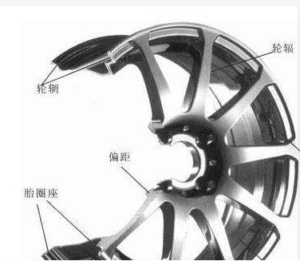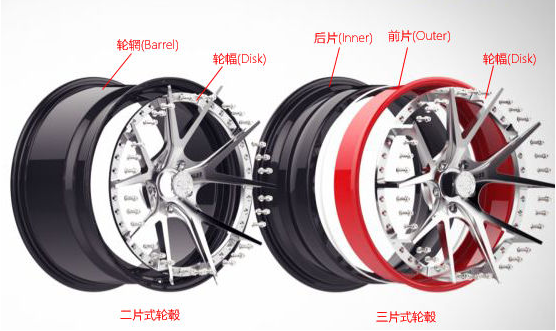Summary: There are some differences between cast and forged wheel rims in the spinning process. Spinning forming technology involves clamping a flat or preformed blank onto the core mold of a spinning machine, rotating the core mold and the blank using the main spindle, and applying pressure to the blank using a spinning wheel to achieve progressive plastic deformation and obtain various shaped workpieces.
- Key points about flow forming wheel rims:
- Flow forming wheel rims are formed using the spinning method and can be referred to as flow forming -cast wheel rims. It is an advanced technology that falls under the branch of “casting.” Wheels produced using the spinning process employ both spinning and casting techniques.
- Flow forming wheel rims have strength and quality comparable to forged wheel rims, making them an intermediate choice between casting and forging. Forged wheel rims have higher strength and use military-grade aluminum, resulting in lighter weight.
- Flow forming -formed wheel rims maintain the metal density and dynamic balance of the entire rim, allowing for significant reduction in material thickness while maintaining sufficient rigidity. This makes the rims lighter and more durable. Compared to ordinary low-pressure cast aluminum alloy wheel rims, the weight of the same-sized flow forming -formed rims can be reduced by 15%.
- The following are the differences between cast and forged wheel rims:

Flow forming wheels vs forged 2

フローフォーミングホイールと鍛造ホイール
In simple terms, the wheel rim is the outermost metal part of the wheel, while the wheel hub is the cylindrical metal component that supports the inner contour of the tire and is mounted on the axle. It is also referred to as the rim, steel rim, wheel, or commonly known as the wheel.
Wheel rims are typically made of aluminum alloy, which can be divided into cast wheel rims and forged wheel rims. The majority of vehicles on the market use cast aluminum alloy wheel rims. Aluminum alloy wheel rims have advantages such as lightweight, aesthetics, ease of processing, and good heat dissipation.
Cast wheel rims:
There are three methods for casting wheel rims: gravity casting, low-pressure casting, and flow forming casting.
Gravity casting: This manufacturing process involves pouring liquid alloy into a mold and allowing it to cool and solidify.
Low-pressure casting involves applying low-pressure to force the liquid alloy into the mold, maintaining a constant pressure to ensure even distribution of the metal molecules and minimize porosity. Low-pressure casting achieves a high yield rate and is suitable for mass production. Currently, most aluminum alloy wheel rims supplied by automobile manufacturers are produced using low-pressure casting.
Flow forming casting combines casting and spinning. The wheel spokes are cast, and the cast wheel rim blank undergoes machining. The spinning process involves rotating and pressing the wheel rim while it is heated. The spinning tool gradually stretches and thins the rim. The casting process is relatively simple and allows for mass production, resulting in lower costs. Flow forming -cast wheel rims exhibit high quality, good flexibility, and lightweight characteristics, combining various processes such as forging, extrusion, stretching, bending, ring rolling, cross rolling, and rolling extrusion.

Flow forming wheels vs forged 4
Forged wheel rims:
Forging involves applying pressure to a metal billet using forging machinery to achieve plastic deformation and obtain forged components with specific mechanical properties, shapes, and dimensions. Forged wheel rims have complex manufacturing processes and higher costs, but they boast excellent performance.
- Forged wheel rims can be further divided into two types:
Single-piece forged wheel rims are integrated, resulting in lighter weight, better dynamic balance, higher reliability, and safety. They eliminate the risk of air leakage and have a more uniform appearance.
Multi-piece forged wheel rims come in two types: two-piece and three-piece. The main distinction lies in their structure. Two-piece forged wheel rims consist of the wheel rim and spokes, while three-piece forged wheel rims consist of front and rear sections and spokes. Multi-piece wheel rims can be connected using specialized bolts/nuts or welding. This allows for the replacement of only the spokes, providing versatility in design. However, multi-piece wheel rims are heavier and have relatively poorer dynamic balance compared to single-piece rims. Therefore, forged wheel rims are considered the better option. - The distinctions between forged and cast wheel rims can be summarized in the following three aspects:
- Process: Cast wheel rims use sand molds, where molten aluminum is poured into the molds and cooled to form the desired shape, followed by machining. Forged wheel rims use steel molds, where heated and softened aluminum billets are placed and shaped through stamping. After cooling, they undergo machining.
- Cost: Casting has a simpler process and lower cost compared to forging, which involves more complex procedures and higher expenses.
- Weight: Forged wheel rims undergo continuous stamping, resulting in a tightly packed molecular structure that can withstand higher pressure. As a result, forged wheel rims are lighter compared to cast wheel rims of the same size and strength. Casting allows for mass production, while forging involves more complex procedures, making it more expensive. In the production process of forged wheel rims, the aluminum billets undergo continuous stamping. The surface treatment of the wheel rims can also be achieved through different methods, In summary, flow forming wheel rims are formed using the spinning process, which combines spinning and casting techniques. They have strength and quality comparable to forged wheel rims, but are not as lightweight. Cast wheel rims are made through casting methods such as gravity casting, low-pressure casting, or flow forming casting. They are commonly used in vehicles and offer lightweight properties, ease of processing, and good heat dissipation. Forged wheel rims, on the other hand, are made through forging processes that involve applying pressure to a metal billet to achieve plastic deformation. They are known for their excellent performance, lighter weight, better dynamic balance, and higher reliability. Cast wheel rims are generally more cost-effective, while forging involves more complex procedures and higher costs.
